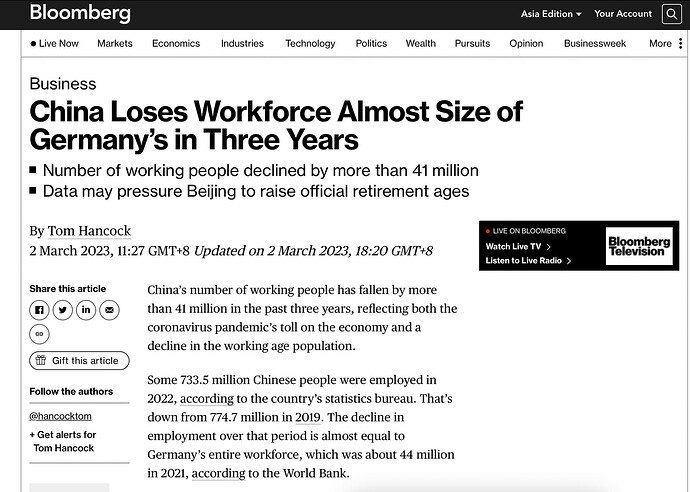-
由于大流行病对经济的影响和劳动年龄人口的减少,中国的劳动人口在过去三年里减少了4100多万。
-
退休的人数迅速上升,导致工作年龄人口的下降速度加快。
-
人口变化是就业率下降的驱动因素,达到60岁的人口急剧增加。
-
由于冠状病毒限制的结束和感染率的急剧下降,中国的经济增长有望在2022年加速,但由于人口老龄化,就业人口的数量可能仍然处于结构性下降趋势。
-
中国的退休年龄四十多年来一直保持不变,男性为60岁,女性白领为55岁,即使是在预期寿命上升的情况下。
-
退休年龄改革已被列为今年的关键经济任务之一,但公众反对任何改变。
-
中国的劳动力已经变得更加城市化,去年63%的工人在城市地区就业,而十年前只有50%。
-
2022年,劳动生产率提高了4.2%,但与2010年代每年约6%的速度相比,已经放缓。
-
China’s working population has decreased by more than 41 million in the past three years due to the pandemic’s impact on the economy and a decline in the working-age population.
-
The number of people retiring has rapidly risen, leading to a faster fall in the working-age population.
-
Demographic change was the driving factor in the drop in employment, with the population reaching the age of 60 increasing dramatically.
-
China’s economic growth is expected to accelerate in 2022 due to the end of coronavirus restrictions and a sharp drop in infections, but the number of employed people may still remain on the structural downtrend due to the aging population.
-
The retirement age in China has remained unchanged for more than four decades at 60 for men and 55 for female white-collar workers, even as life expectancy has risen.
-
Retirement age reform has been listed among the key economic tasks for the year, but there is public opposition to any changes.
-
China’s workforce has become more urbanized, with 63% of workers employed in urban areas last year, up from 50% a decade ago.
-
Labor productivity increased by 4.2% in 2022, but it has slowed down from rates of around 6% per year in the 2010s.
